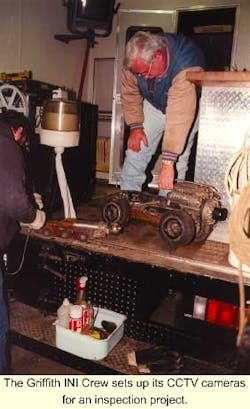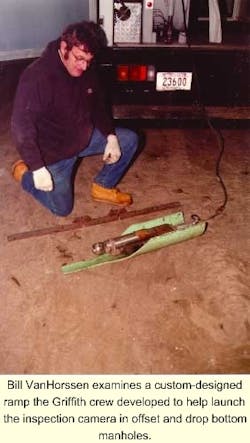Collection System Issues: Town Finds Silver Lining In Federal Mandates
By Suzan Marie Chin
It is said by some that two of the biggest un-truths ever stated are "the check is in the mail" and "Hi, we're from the federal government and we're here to help you." The latter did turn out to be a true statement however for the Town of Griffith, IN, after implementating a successful program required by a federal mandate to eliminate environmental and sewer system problems.
Griffith is an urban community of about 19,000 residents, approximately 45 minutes from Chicago, immediately south of Lake Michigan in Northwest Indiana. Because of its proximity to the lake, it encounters prevailing winds from the north and a great deal of snow in the winter. The town was built on a marsh land area recovered from Lake Michigan. This creates a challenge in dealing with stormwater and a high water table. The town has a limited number of drainage facilities, the main runoff being located in Cady Marsh ditch at the northern end of the community. The runoff eventually flows into the Calumet River north of the town.
The town pumps its sanitary sewers through a lift station to the neighboring Hammond Sanitary District for treatment. In 1996, due to the amount of sanitary and storm drains in the town, heavy rain events flooded the pump facility and water backed up into homes.
"We would have to start pumping raw wastewater, mixed with storm water, into the Little Calumet River in order to protect the health and safety of the homeowners," said Ron Cooper, Supervisor of the Infiltration and Inflow Crew for the Town of Griffith.
The U.S. EPA and Indiana Department of Environmental Management (IDEM) frowned on this and sued Griffith. The town attorneys negotiated with the government. It was agreed by mandate that Griffith would complete an inflow infiltration study to investigate and identify the cause of the flooding. Also required by the mandate were a new pump station to be built and all of the town's sanitary and storm sewers to be cleaned and inspected by closed circuit television.
Until this time, cleaning and television inspection of the system had been performed by outside contractors. In drawing up the program to meet the mandate, the town council in conjunction with its engineering firm decided it would be more economical for the town to hire a crew and buy the equipment to complete the project. The specs were drawn up and the town acquired a Vactor sewer cleaning truck and a Pearpoint video inspection vehicle, camera system and two tractors as well as the typical accessories and tools such as gas meters, tripods and CSE equipment.
Almost 50 percent of the inspection work was located in easements so Griffith also purchased a trailer to transport portable jetting equipment and an additional Pearpoint cable reel and controller unit to work with the cameras from the inspection vehicles in these areas.
In 1997, Griffith embarked on it's mandated 10-year program to identify all of the system's problems, map the system, clean and TV inspect all sewers. The city also disconnected those individual lines that were in violation and properly reconnected them. The accurate and detailed mapping of the system was critical.
"The mapping is so important to a community in order to identify the work that needs to be done, where the system is performing and where it needs to be improved and to plan properly for growth," said Jim Reyome, Director of Public Works for Griffith.
With this in mind, the mapping technician works closely on a day-to-day basis with the Inflow and Infiltration (INI) crew to ensure the mapping accuracy as the project progresses.
During the inspection process, the INI crew identifies and designates obstructions and problems and recommends a course of action and timetable for repair. A detailed accounting of the findings and recommendations is reported by the city attorney to the government on a quarterly basis. This detailed tracking enables the department to budget and plan preventative measures to eliminate potentially serious problems.
For instance, during an inspection the crew encountered a 6 inch storm line tied into a sanitary contributor. The storm line was pumping more than 1 million gallons a day into the sanitary sewer, potentially causing an overload of the sanitary pumps. A situation like this presents a big problem for a community like Griffith, since it sends all sanitary effluent to another community to be treated.
"Treatment is charged by the gallon, so having a million gallons of storm water surging into the sanitary system on a daily basis was costing the taxpayers extra monies to treat water that wouldn't be treated otherwise," Reyome said.
The incorrect tie-in most likely occurred due to an engineering or contractor oversight when the town completed a general separation of its storm and sanitary sewers in 1970. Like most older and smaller communities throughout the Midwest, the storm and sanitary sewer systems were at one time unified. Federal laws mandated the separation and this was often accomplished by taking the combined sewer and designating it as either sanitary or storm, separating the lines, building a new sewer along side of it and reconnecting the lines back into the respective systems.
"By having our inspection program in place, errors like this have been discovered and corrected effectively," said Cooper.
Reyome added, "Many communities are facing the same type of problems that we have dealt with in Griffith because they have not been pushed into moving in a different direction. They are continuing to use combined sewer systems but this can be changed."
Griffith has numerous offset manholes and drop bottom manholes where the influent pipe is halfway up the manhole so it acts as a catch basin. In this situation, the inspection camera cannot be set on the bottom of the line.
The crew had to develop a way to get the camera down the pipe without setting it on the bottom. Their solution was to create a ramp using PVC pipe (Schedule 35 water), cut in half lengthwise and tapered at the ends. They used chains to suspended the ramp from a piece of steel across the top of the manhole, and used the ramp to guide the camera into the pipe.
As of September 2000, the INI crew had completed the cleaning and inspection of approximately 1,093,804 feet of sanitary sewer and 900,000 feet of storm sewer. This equates to about 75 percent of the sanitary system and 60 percent of the storm system. The crew is accomplishing more at a faster rate than anyone expected but the program most likely will take nine years to complete in full. At that point, the department plans to develop a routine cleaning and inspection program to continue the positive impact this work has had on the community.
Conclusion
The mandate has brought expense, lots of hard work and investment for the town of Griffith, but its present and future impact on the community have proved more beneficial than anticipated. The community now realizes the benefits of maintaining, cleaning and inspecting the system.
"The program has significantly offset the emergency situations and expenditures that developed in the past and would have continued without this successful program being in place," Reyome said, "money has been well spent and the negative cause that got us into the program has created a positive effect for the community that will last for years to come."
About the Author:
Suzan Marie Chin is Director of Marketing for Pearpoint.


